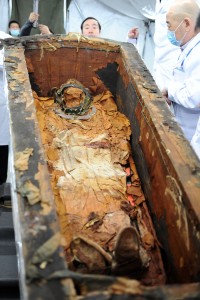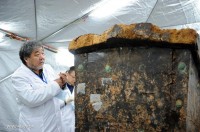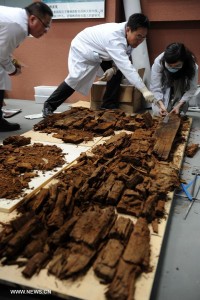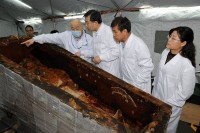 Archaeologists in northern China’s Inner Mongolia Autonomous Region have unearthed a lacquer coffin from the Northern Wei Dynasty (386 to 534 A.D.), snatching it out from under the nose of looters. The looters were caught digging a tunnel 10 meters (33 feet) long towards the tomb entrance, which is how archaeologists knew where to dig.
Archaeologists in northern China’s Inner Mongolia Autonomous Region have unearthed a lacquer coffin from the Northern Wei Dynasty (386 to 534 A.D.), snatching it out from under the nose of looters. The looters were caught digging a tunnel 10 meters (33 feet) long towards the tomb entrance, which is how archaeologists knew where to dig.
Tombs of aristocrats from the Northern Wei Dynasty have been found before in the Xilin Gol Grassland, a prairie region in Inner Mongolia that has been home to nomadic tribes since the Bronze Age Shang Dynasty in the 16th century B.C. Most recently, two tombs have been unearthed in the past two years in locations adjacent to the one that was just discovered. The potential for treasure in these tombs has attracted thieves who are so bold they often act as parasites on official archaeological projects, digging the same site at night that the professionals are excavating during the day. It’s a lucky break that they were caught in this instance before they destroyed the archaeological context in their search for salable goods.
 On March 7th, the large black-lacquered pinewood coffin was removed from the tomb along with archaeological context material like soil and wood and brought to a laboratory at the Xilin Gol League Museum in Xilin Hot, Inner Mongolia. The next day, the coffin was gingerly opened to reveal the mortal remains of an aristocratic woman in excellent condition. She was wrapped in a silk shroud and wearing fur boots. Her thick black hair was adorned with a metal headband. She was buried with goods including a bow, a dagger and various pottery vessels.
On March 7th, the large black-lacquered pinewood coffin was removed from the tomb along with archaeological context material like soil and wood and brought to a laboratory at the Xilin Gol League Museum in Xilin Hot, Inner Mongolia. The next day, the coffin was gingerly opened to reveal the mortal remains of an aristocratic woman in excellent condition. She was wrapped in a silk shroud and wearing fur boots. Her thick black hair was adorned with a metal headband. She was buried with goods including a bow, a dagger and various pottery vessels.
 Archaeologists have not found any indication of the identity of the deceased, but they hope that analysis will reveal much about her life and death. Samples of her hair will be tested for information about her diet, age and health. The well-preserved contents of the coffin and tomb will hopefully provide experts with new insight into the funerary customs of ancient Xianbei nomadic tribes who inhabited the area. There were many tribes under the Xianbei umbrella. Researchers hope to narrow down which clan the aristocratic woman belonged to.
Archaeologists have not found any indication of the identity of the deceased, but they hope that analysis will reveal much about her life and death. Samples of her hair will be tested for information about her diet, age and health. The well-preserved contents of the coffin and tomb will hopefully provide experts with new insight into the funerary customs of ancient Xianbei nomadic tribes who inhabited the area. There were many tribes under the Xianbei umbrella. Researchers hope to narrow down which clan the aristocratic woman belonged to.
One of the Tuoba tribe, Tuoba Liwei, was posthumously considered the first emperor of the Northern Wei Dynasty. Although China was briefly unified under the Northern Wei in 439 A.D., when the dynasty came to  power it employed customs and practices that were foreign to the ethnic Chinese majority, like requiring would-be empresses not to be of high birth, but to be able to forge gold statues during a ceremony, and forcing the mothers of crown princes to commit suicide and instead giving princes’ wet nurses dowager empress status. As the dynasty expanded and fused with neighboring ethnic groups, these distinct practices fell out of favor.
power it employed customs and practices that were foreign to the ethnic Chinese majority, like requiring would-be empresses not to be of high birth, but to be able to forge gold statues during a ceremony, and forcing the mothers of crown princes to commit suicide and instead giving princes’ wet nurses dowager empress status. As the dynasty expanded and fused with neighboring ethnic groups, these distinct practices fell out of favor.
Fascinating, because so unusual, customs in your final paragraph.
Strange – What appears to be that metal head band looks almost like some sort of medieval chastity belt. As I cannot see the black hair, I assume that what there isn’t lacquer or wood is in fact silk. The state of preservation -in a wet environment underneath of a tumulus- is remarkable. To sum it all up, it would be really great to see a full reconstruction of what there might have been an ‘armed and dangerous’ Great- grand- grandmother of little Genghis Khan.
Since the archaeologists have found the Mongolian woman, they can find new information that might be useful. It’s a good thing that the archaeologists caught the looters that were trying to get the salable goods. Because of the good condition that the lady was found in, this could be evidence that the Mongolians had a fine way of doing things like burying their deceased. Since the woman found in the tomb had some valuables with her, it can show that she was important to some one or a group of people.
It is interesting to know how the lady that was found in the tomb had materials such as silk. This made me realize how important their materials were to them. I can not see the body of the woman but it would be interesting to look at all the details that are in the tomb. It is also interesting to see how they kept the bodies preserved. I hope the archaeologists find more background information on her.
I find it amazing that the tomb went untouched for so long and the items inside were in great condition. The items found with the women, a bow, headband, a dagger and various pottery vessels must have been important to their culture as the women was buried with the items. with all of the items buried with this women, I hope to find out how important she was to her culture.
The woman was of a higher class being buried with a shroud of silk and fur boots. She was buried with goods including a bow, a dagger and various pottery vessels which were more than likely significant to their culture. The graves are also very valuable considering gravediggers go through such risk to dig them up while the archaeologists sleep.
It’s fascinating how the woman’s tomb wasn’t found until the archaeologists started digging and found the gravediggers risking their lives for the items she was buried with; the silk, dagger, bow, and pottery vessels.
It is very fascinating that the mummy was wrapped in silk, very fancy material…and 1,500 year old tomb? That’s amazing. Just to know she lived, and walked in Mongolia.the head band has a medieval look to it. because of the way she was buried it showed how well advanced the Mongolians were in burial. It’s amazing how the items were in such good condition after all of these years. Makes you wonder!! :skull: